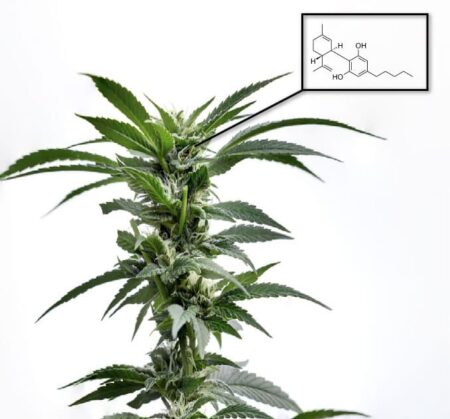List of Cannabinoids
The legalization of CBD in the United States opened the door for many people into the curiosity of different cannabinoids. Historically, it was quite hard to find information on different cannabinoids, all in one location. We list each cannabinoid, one by one, and allow the reader to learn very detailed information about each of them. The list of cannabinoids located on this page are differentiated between major and minor occurrences within the cannabis plant. These terms are defined by National Center for Complementary and Integrative Health, or NCCIH, and can be found in a study conducted by clicking here.
Also, keep in mind that this list of cannabinoids is most likely in a constant state of change and revision. Visit periodically for the most up-to-date information. As research in the cannabis field continues to increase, so will the list of cannabinoids on both the page and the cannabinoid locator tool.
**Looking for cannabinoid information that you don’t see here? Have further questions about cannabinoids? Please email us with your request, and we will get back with you as soon as possible. Please keep in mind that this is a free service, and our queue is normally filled.
Cannabinoids in Cannabis
can·nab·i·noid
any of a group of closely related compounds which include cannabinol and the active constituents of cannabis.
Check out the tables below for a breakdown of the list of cannabinoids in cannabis. Remember, these are only the known cannabinoids found in the cannabis plant. The likelihood of there being more cannabinoids that exist is quite high.
We’ve also included the two primary endocannabinoids, Anandamide and 2-Arachidonoylglycerol for those who are interested in what the body produces.
Search All Known Cannabinoids
Alternatively, you can manually look for a cannabinoid with the cannabinoid finder search feature above.
List of Major Cannabinoids
 CBD, Cannabidiol
CBD, Cannabidiol
Cannabidiol (CBD)
Cannabidiolic Acid (CBDA)
Cannabidiorcol (CBDC1)
Cannabidiol-C4 (CBDC4)
Cannabidiol dimethyl ether (CBDD)
Cannabidiol Monomethylether (CBDM)
Cannabidivarin (CBDV)
Cannabidivarinic Acid (CBDVA)
 THC, Tetrahydrocannabinol
THC, Tetrahydrocannabinol
Tetrahydrocannabinol, (THC)
10-oxo-delta-6a-tetrahydrocannabinol, (OTHC)
Delta-8-tetrahydrocannabinolic acid, (Δ8-THCA)
Delta-8-tetrahydrocannabinol (d8THC, Δ8-THC)
Delta-9-tetrahydrocannabinol (d9THC, Δ9-THC)
Delta-9-tetrahydrocannabinol-C4 (THC-C4)
Delta-9-tetrahydrocannabinolic acid A (Δ9-THCA, THCA-C5)
Delta-9-tetrahydrocannabinolic acid B (Δ9-THCB, THCA-B)
Delta-9-tetrahydrocannabiorolic acid, (Δ9-THCA-C1, THCA-C1)
Delta-9-tetrahydrocannabinolic acid C4, (Δ9-THCA-C4, THCA-C4)
Tetrahydrocannabinol(−)-cis-Δ (THC-C5)
Delta-9-tetrahydrocannabiorcol (Δ9-THCO-C1)
Delta-9-Tetrahydrocannabiorcolic acid A (THCOA)
Delta-9-tetrahydrocannabivarin (THCV)
Delta-9-tetrahydrocannabivarinic acid A (THCVA)
TriHydroxy-delta-9-tetrahydrocannabinol (TRIOH-THC)
Delta-10-tetrahydrocannabinol (D10THC, Δ10THC)
Tetrahydrocannabiphorol (THCP)
THC-O Acetate (THCO)
Hexahydrocannabinol (HHC)
List of Minor Cannabinoids
 CBC, Cannabichromene
CBC, Cannabichromene
Cannabichromene (CBC)
Cannabichromenic Acid A (CBCA)
Cannabichromanon (CBCN-C5)
Cannabichromanone-C3 (CBCN-C3)
Cannabicoumaronone (CBCON-C5)
Cannabichromevarin (CBCV)
Cannabichromevarinic Acid A (CBCVA)
 CBE, Cannabielsoin
CBE, Cannabielsoin
Cannabielsoin (CBE-C5)
-C3-Cannabielsoin (CBE-C3)
Cannabielsoic Acid A (CBEA-C5 A )
Cannabielsoic Acid B (CBEA-C5 B)
C3-Cannabielsoicacid B (CBEA-C3 B)
CannabiglendolC3 (OH-iso-HHCVC3)
Dehydrocannabifuran (DCBF-C5)
Cannabifuran (CBF-C5)
 CBT, Cannabitran
CBT, Cannabitran
Cannabitriol (CBT)
Cannabitriolvarin (CBTV)
10-Ethoxy-9-hydroxy-delta-6a-tetrahydrocannabinol
8,9-Dihydroxy-delta-6a-tetrahydrocannabinol (8,9-Di-OH)
9,10-Dihydroxyhexahydrocannabinol, Cannabiripsol (Cannabiripsol-C5)
6a,7,10aTrihydroxyΔ9-tetrahydrocannabinol10-OxoΔ6a(10a)tetrahydrocannabinol
OTHC
Trans-Cannabitriol (Trans-CBT-C5)
Cannabitriol-C3 (TransCBT-C3)
Trans10-O-Ethylcannabitriol (TransCBT-OEt-C5)
Primary EndoCannabinoids
Isocannabinoids
 Isocannabinoids
Isocannabinoids
Isotetrahydrocannabinol
Isotetrahydrocannabivarin
Isotetrahydrocannabivarin
Uncategorized
Different Types of Cannabinoids
There are, generally, three different types of cannabinoids that we refer to:
- Phytocannabinoids
- Endocannabinoids
- Synthetic cannabinoids
- Isocannabinoids
Phytocannabinoids are plant chemicals, found mainly in cannabis plants. Endocannabinoids are naturally made by our bodies, and are essentially lipid-based neurotransmitters. Synthetic cannabinoids are made by humans in a laboratory. Isocannabinoids are defined as a transformed cannabinoid into a different isomer.
All Known Cannabinoids
Our database includes a list of all known cannabinoids. Each cannabinoid profile contains the name, chemical structure, how it’s used, and a list of potential therapeutic benefits. We stress ‘potential’ because even though we understand that some of these cannabinoids can help people, there haven’t been actual clinical trials on most of them – so we can’t officially make the claims. The FDA is very strict on this. All known cannabinoids do not necessarily offer benefits, so we have to be careful in this regard.
At New Phase Blends, we try hard to link all cannabinoid profiles to peer reviewed studies and trials. Contact us with any developing information you may have, and we will review it.



 CBD, Cannabidiol
CBD, Cannabidiol